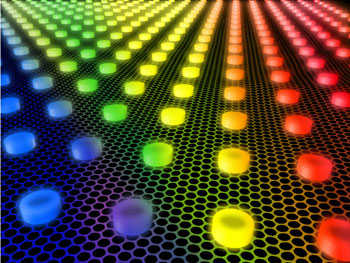| Dec 09, 2011 |
Researchers enhance graphene to enable multicolor photodetection
|
|
(Nanowerk News) Graphene, a one-atom–thick layer of carbon lattice with a honeycomb structure, is seen as an attractive semiconductor material for use in future electronics and optoelectronics because of its speed, transparency, flexibility and strength. Recent studies have demonstrated its potential in solar cells, touch panels, ultra-fast lasers and optical modulators.
|
 |
| Plasmonic nanostructures coupled with graphene
|
|
And while graphene has the potential for wideband, high-speed photodetection — the sensing of light or other electromagnetic energy — it is currently hampered by its low external sensitivity to light and its inability to differentiate different colors of light.
|
|
Now, researchers from the UCLA Henry Samueli School of Engineering and Applied Science and the department of chemistry and biochemistry in the UCLA College of Letters and Science have found that by coupling graphene with metallic plasmonic nanostructures, they can overcome these limitations, greatly enhancing the local light intensity, improving overall light sensitivity and enabling the highly specific detection of multiple colors (Paper in Nature Communications: "Plasmon resonance enhanced multicolour photodetection by graphene"). Such structures could be used to concentrate, guide or filter light on the nanoscale in sensors and various other devices.
|
|
The new development could broadly impact a variety of areas, including image sensor arrays, bio-sensing and communications.
|

